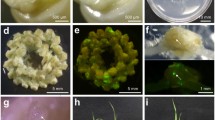Abstract
We have developed a method for the accelerated production of fertile transgenic wheat (Triticum aestivum L.) that yields rooted plants ready for transfer to soil in 8–9 weeks (56–66 days) after the initiation of cultures. This was made possible by improvements in the procedures used for culture, bombardment, and selection. Cultured immature embryos were given a 4–6 h pre-and 16 h post-bombardment osmotic treatment. The most consistent and satisfactory results were obtained with 30 μg of gold particles/bombardment. No clear correlation was found between the frequencies of transient expression and stable transformation. The highest rates of regeneration and transformation were obtained when callus formation after bombardment was limited to two weeks in the dark, with or without selection, followed by selection during regeneration under light. Selection with bialaphos, and not phosphinothricin, yielded more vigorously growing transformed plantlets. The elongation of dark green plantlets in the presence of 4–5 mg/l bialaphos was found to be reliable for identifying transformed plants. Eighty independent transgenic wheat lines were produced in this study. Under optimum conditions, 32 transformed wheat plants were obtained from 2100 immature embryos in 56–66 days, making it possible to obtain R3 homozygous plants in less than a year.
Similar content being viewed by others
References
Beeker, D, R Brettschneider, H Lörz (1994) Fertile transgenic wheat from microproprojectile bombardment of scutellar tissue. Plant J 5:299–307.
Blechl AE, OD Anderson (1996) Expression of a novel high molecular weight glutenin subunit in transgenic wheat. Nature Biotechnology (in press).
Christensen AH, RA Sharrock and PH Quail (1992) Maize ubiquitin genes: structure, thermal perturbation of expression and transcript splicing, and promoter activity following transfer to protoplasts by eleetroporation. Plant Mol Biol 18:675–689.
Dennehey BK, WL Petersen, C Ford-Santino, M Pajeau, CL Armstrong (1994) Comparison of selective agents for use with the selectable marker genebar in maize transformation. Plant Cell Tissue Organ Cult 36:1–7.
Jefferson RA (1987) Assaying chimeric genes in plants: The GUS gene fusion system. Plant Mol Biol Rep 5:387–405.
Murashige T, F Skoog (1962) A revised medium for rapid growth and bioassays with tobacco tissue cultures. Physiol Plant 15:473–497.
Nehra NS, RN Chibbar, N Leung, K Caswell, C Mallard, L Steinhauer, M Baga, KK Kartha (1994) Self-fertile transgenic wheat plants regenerated from isolated scutellar tissues following microprojectile bombardment with two distinct gene constructs. Plant J 5:285–297.
Ozias-Akins P, IK Vasil (1982) Plant regeneration from cultured immature embryos and inflorescences ofTriticum aestivum L. (wheat): evidence for somatic embryogenesis. Protoplasma 110:95–105.
Sanford JC, MJ De Vit, JA Russell, FD Smith, PR Harpending, MK Roy, SA. Johnson (1991) An improved, helium-driven biolistic device. Technique 3:3–16.
Spencer TM, WJ Gordon-Kamm, RJ Daines, WG Start, PG Lemaux (1990) Bialaphos selection of stable transformants from maize cell culture. Theor Appl Genet 79:625–631.
Srivastava V, V Vasil, IK Vasil (1996) Molecular characterization of the fate of transgenes in transformed wheat (Triticum aestivum L.). Theor Appl Genet (in press).
Vain P, MD McMullen, JJ Finer (1993) Osmotic treatment enhances particle bombardment mediated transient and stable transformation of maize. Plant Cell Rep 12:84–88.
Vasil IK (1994) Molecular improvement of cereals. Plant Mol Biol 25:925–937.
Vasil V, AM Castillo, ME Fromm, IK Vasil (1992) Herbicide resistant fertile transgenic wheat plants obtained by microprojectile bombardment of regencrable embryogenic callus. Bio/Technology 10:667–674.
Vasil V, V Srivastava, AM Castillo, ME Fromm, IK Vasil (1993) Rapid production of transgenic wheat plants by direct bombardment of cultured immature embryos. Bio/Technology 11:1553–1558.
Weeks JT, OD Anderson, AE Blechl (1993) Rapid production of multiple independent lines of fertile transgenic wheat (Triticum aestivum). Plant Physiol 102:1077–1084.
Zhou H, JW Arrowsmith, ME Fromm, CM Hironaka, ML Taylor, D Rodriquez, ME Pajeau, SM Brown, CG Santino, JE Fry (1995) Glyphosate-tolerant CP4 and GOX genes as a selectable marker in wheat transformation. Plant Cell Rep 15:159–163.
Author information
Authors and Affiliations
Additional information
Communicated by J. M. Widholm
Rights and permissions
About this article
Cite this article
Altpeter, F., Vasil, V., Srivastava, V. et al. Accelerated production of transgenic wheat (Triticum aestivum L.) plants. Plant Cell Reports 16, 12–17 (1996). https://doi.org/10.1007/BF01275440
Received:
Revised:
Issue Date:
DOI: https://doi.org/10.1007/BF01275440



